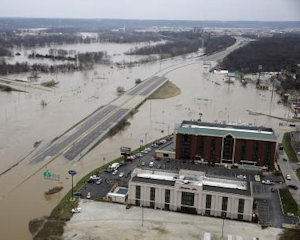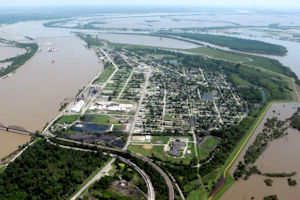Historic St. Louis Flooding is Manmade
 | | At least the sun is shining |
I write this from my secure bunker in suburban St. Louis, with my wife and son held close. We cannot leave, as all the major roads out of the area are closed for the foreseeable future. I get the occasional phone calls from school officials, social media updates from political leaders, and emails from the city updating us on the situation, but the bottom line is simple: everything is underwater. Thankfully, I can still communicate with you, dear readers, for as long as the power and broadband hold. I just hate myself for procrastinating on that ark project.
I exaggerate, but only a little. For those of us in the greater St. Louis area, it's fairly frightening right now, with the nearby Meramec River spilling over everything. It gets more troubling the farther south you go, and areas in Southern Missouri banked by the Mississippi are facing the worst of it. Low-lying areas and flood zones are underwater right now, and thousands have already been displaced, with hundreds of homes and businesses facing potential ruin as levees and sandbags bulge under the growing weight of ever-rising waters. People are already dying, and the rain hasn't stopped yet. I'm one of the lucky ones, and I definitely owe my realter an extra bit of thanks for selling us a house that is all but immune to flooding.
That said, there's no sugar-coating it: this natural disaster is catastophic. As someone who spent the first two decades of his life in Central Florida, the only flooding I am intimately familiar with is caused by hurricane-based tidal surges. This kind of flooding--the slow, steady rise of a major river that won't let up--is new to me. When I hear this is some of the worst flooding the area has seen in the last five hundred years, it's hard to wrap my brain around it. For officials and first responders in the tri-state area, this is the time to shine and focus entirely on disaster relief, but for me, there's naught to do but wonder why this is happening.
Imagine my surprise to discover that we were warned about this. After similar floods hit the area in late 2015/early 2016, the Great Rivers Habitat Alliance commissioned a report through a private engineering firm that essentially confirmed what many long suspected: levees in Valley Park, a large area West of St. Louis along the Meramec River (which flows East, ultimately dumping into the Mississippi), were built much too high, and that exacerbates flooding downstream. (There's also the matter of a Valley Park landfill that was recently expanded along the river, acting as a small bottleneck.) Other studies around the same event contained similar conclusions, including one by Robert Criss, PhD, at Washington University in St. Louis, that argues that most statistical models used to dictate the efficacy of engineering projects and predict future floods make a critical error by assuming a static--rather than a predictably growing--population size.
 | | The Valley Park levees don't always work as advertised |
Levees, it turns out, aren't much of a solution. Flood waters are going to go somewhere, so while they might simply go up and remain contained by the levees of Valley Park, they're going to be released in higher quantities further down the river, i.e. where I live. That's why we can see historic flood levels without having historic--or even all that unusual--amounts of rainfall. Granted, a changing climate (manmade or not--I'm not going to get into it here) makes things even worse, but thankfully, climate change is a minor factor--almost an irrelevant one--in this case.
You'd be forgiven if you imagined the problems of river flooding have a relatively simple solution in the use of levee systems to divert flood waters to places where flooding is more acceptable. Unfortunately, it's never that simple. For one thing, levees break, as anyone who remembers Hurricane Katrina can tell you, and most of the existing levees in America are in dangerously bad shape (granted, I'm taking the word of a federal agency seeking funding). Building and maintaining them gets prohibitively expensive, even in the short term, so the prospect of using enormous systems of levees to control flooding is not one to be taken lightly when weighing federal, state, and municipal priorities. But even if economics weren't a factor, there aren't nearly enough riverside areas that are expendable enough to bear the burden of artificially inflated annual flooding.
Take, for instance, a proposed alteration to the New Madrid Floodway, which aims to protect farmland throughout Southeastern Missouri by way of a series of levees and other flood barriers. Unfortunately, while this engineering project would undoubtably improve things for Missourians like me, it is vehemently opposed by the small communities along the Eastern bank of the Mississippi, such as Cairo, Illinois. Cairo is a town of nearly three thousand people, and when major floods hit the Mississippi (something that happens more often now, thanks to things like the Valley Park levees), the floodway is designed to flood the entire town in order to save farmland that feeds over a million.
 | | Keep in mind that Cairo, Illinois is an impoverished town that is 70% African American and dealing with major infrastructure problems |
But even with such a harrowing ethical dilemma as the end result, it's not that simple. When the floodway works according to plan, there are still more complications, more downstream effects. Every action up the river causes a reaction down the river. It's a beautiful demonstration of a universal truth, and one that's hard to work around. This is not to say every attempt to control nature is futile--only the most rabid and extreme of environmentalists would argue that--but we must be aware of the very real consequences that come from even our most well-intentioned aims, and we must be ever vigilant to the merciless whims of Chaos Theory.
Which brings me back to where I am now, sitting in my deluge-ravaged home as rivers overtake all the major roads around me, threatening to turn my neighborhood into an island surrounded by misery and anguish, all so nearby Valley Park could imagine living without such troubles. (Ironically, despite all of this, Valley Park is still flooding.) Thing is, I'm not all that upset about the levees. Floods are going to happen, and there's nothing we can do with current technology to stop that. Even if we could magically stop floods from ever taking another home or displacing another business, there would be unforeseen consequences to deal with. That's life.
-e. magill 5/4/2017
|
|